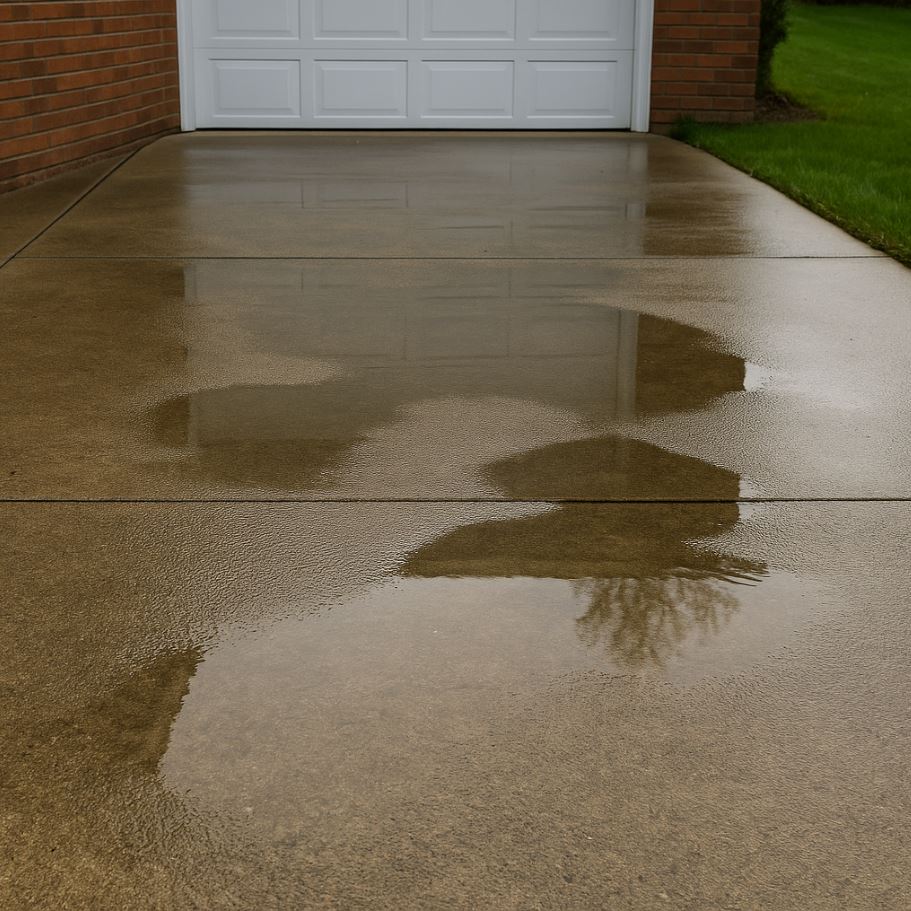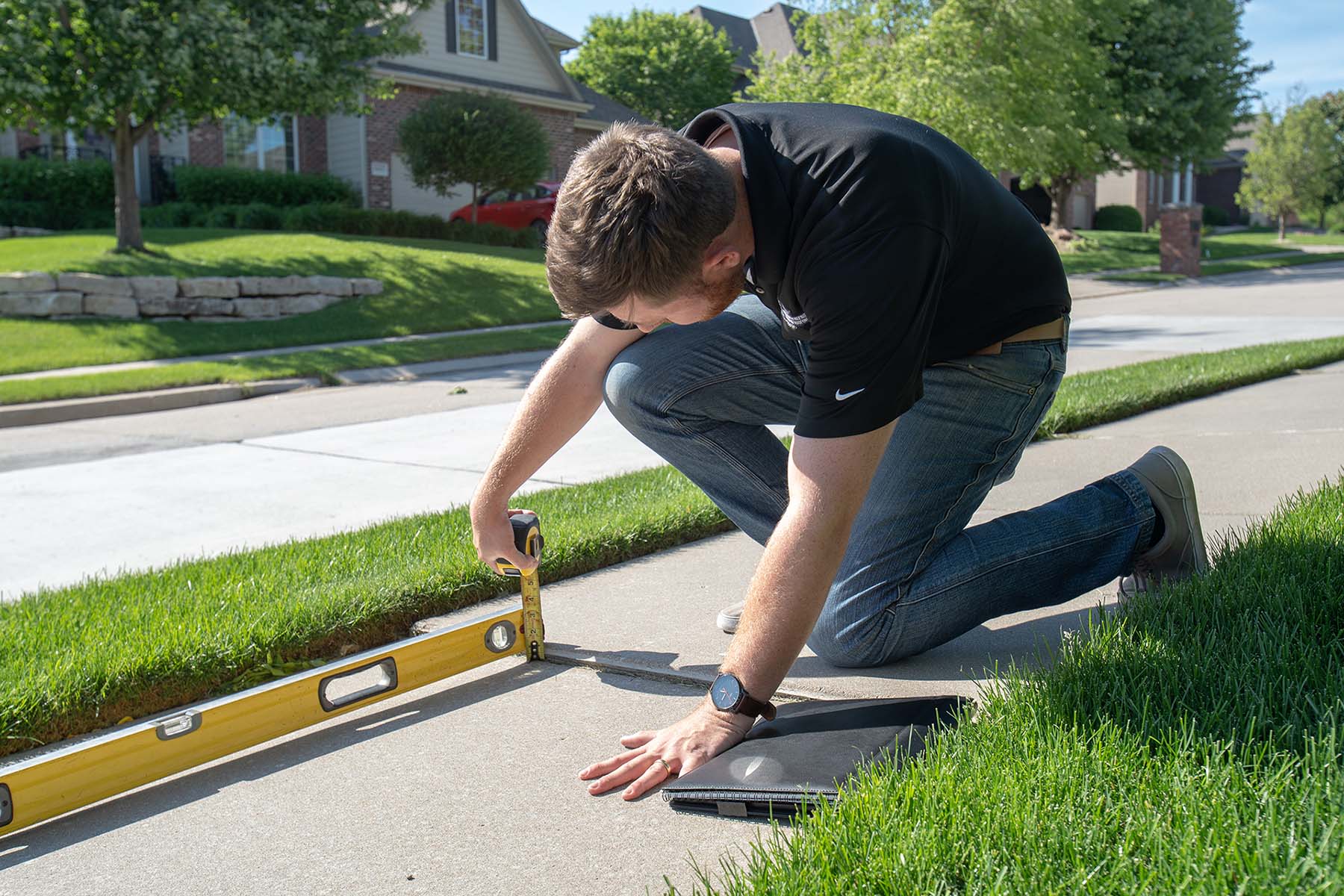If you’re noticing puddles forming on your driveway or sidewalk after it rains, it could be more than just poor drainage. Pooling water often means the concrete has settled unevenly, creating low spots that collect runoff.



After a rainstorm, you expect water to run off your driveway, patio, or sidewalk, not sit there in a puddle. But if you’re noticing standing water that lingers long after everything else has dried, it could be a sign that your concrete has started to settle unevenly.
Pooling water isn’t just a nuisance. It often means the slab has shifted, creating low spots that collect runoff instead of draining properly. Left unaddressed, those low areas can lead to cracks, erosion, or even water seeping toward your home’s foundation.
At Anchored Walls, we’ve seen how small puddles can point to much larger issues beneath the surface. Our team can assess what’s causing the unevenness and provide a lasting solution to lift and level the slab, restoring safety, drainage, and peace of mind.
Water should drain away from your home, not collect in pools across your driveway or patio. When it doesn’t, it’s usually because something has shifted beneath the surface.
Here are the most common reasons concrete slabs begin to hold water:
Soil settlement
Over time, the soil beneath your concrete can compact or erode, especially after heavy rains or long dry spells. When that support shifts, the slab settles unevenly, creating low spots where water naturally collects.
Washout and erosion
Poor drainage around your property can lead to water washing away the soil beneath sidewalks, steps, or patio corners. This loss of support causes the slab to sink in places, forming puddles and cracks.
Improper grading or installation
Sometimes the problem starts with how the concrete was poured. If it wasn’t properly sloped to encourage runoff, or if expansion joints were placed poorly, water may begin to pool even on a new surface.
Cracks and joint separation
As slabs shift and crack, those cracks can open slightly and cause the concrete to dip along one side. Even a small shift is enough to change the flow of water and create a collection point.
If you’re noticing puddles that form in the same spots every time it rains, the concrete likely isn’t the problem on the surface; it’s what’s happening underneath.
It’s easy to dismiss a puddle as a minor annoyance, but standing water on concrete is often an early warning sign. If the slab is starting to shift or settle, those low spots will only get worse over time, and the water they hold can speed up the damage.
Here’s why it matters:
Slipping hazard
Wet concrete is slippery, especially on smooth surfaces like driveways and walkways. Pooling water increases the risk of slips and falls for family members, guests, or anyone delivering packages to your door.
More cracking and movement
When water collects in one area, it puts pressure on the slab and the soil beneath it. That constant moisture softens the base and can lead to further sinking, cracking, or separation.
Foundation risks
Water that doesn’t drain properly often moves toward your home. Over time, that can lead to moisture intrusion along foundation walls or into the basement, especially in older homes without proper grading or drainage systems.
Freeze-thaw damage
In colder months, pooled water can freeze and expand in low spots or cracks, worsening the damage. That cycle of freezing and thawing can accelerate the breakdown of the slab’s surface.
Concrete doesn’t fix itself
Once a slab settles, it won’t return to its original position on its own. Pooling is usually a sign that the concrete has already moved, and without repair, it will likely continue to sink.
If you’re stepping over puddles every time it rains, it’s time to take a closer look. Anchored Walls can help identify what’s going on beneath the slab and lift it back into place.
At Anchored Walls, we use a modern concrete lifting method that raises sunken slabs with precision and without tearing out or replacing the concrete. Our polyurethane injection process fills the voids beneath the surface and lifts the slab back into proper position.
Here’s how it works:
Our poly fill system is fast, clean, and designed to last. Unlike traditional mudjacking, polyurethane doesn’t add unnecessary weight to the soil. It cures quickly, resists water, and provides stable long-term support that helps eliminate pooling and future sinking.
We’ve used this system to fix driveways, sidewalks, patios, and garage floors across Missouri and Iowa. If water is collecting where it shouldn’t, Anchored Walls can lift the slab and restore the proper slope so your concrete drains the way it was meant to.
Pooling water on your driveway or patio isn’t just inconvenient; it’s often the first sign that your concrete has started to settle. The longer the slab stays uneven, the more likely it is to crack, shift, or lead to water where it doesn’t belong.
At Anchored Walls, we make it easy to find out what’s really going on. Our team has been helping homeowners in Missouri and Iowa for over 40 years, using modern slab-lifting solutions that are fast, clean, and built to last. If you’re ready to stop stepping over puddles, we’re ready to help. Schedule a free concrete evaluation today, and let us restore the safety and function of your concrete without the cost of full replacement.



By submitting this form and signing up for texts, you consent to receive text messages from Anchored Walls at the number provided, including messages sent by auto dialer. These may include messages related to estimates, project updates, appointment scheduling, and promotional offers. Consent is not a condition of purchase. Msg & data rates may apply. Msg frequency varies. Unsubscribe at any time by replying STOP or clicking the unsubscribe link (where available) and no further messages will be sent. Reply HELP for help. Information will not be shared with third parties for marketing or promotional purposes. Privacy Policy